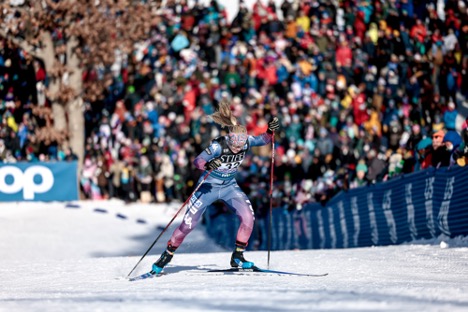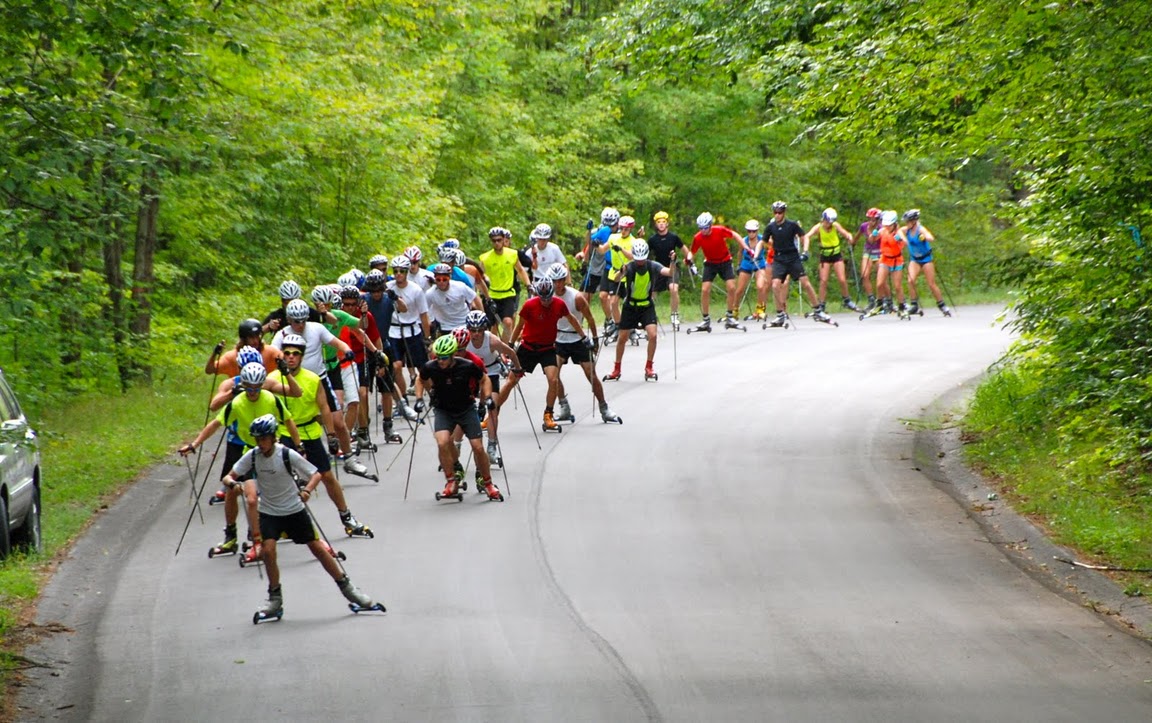This is part II of an interview with U.S. biathlete Susan Dunklee. In her final season racing World Cup, Dunklee has decided to take on a leadership role, as an Athlete Ambassador for gender equity, with the International Biathlon Union. You can find part one of the interview here.
This portion of the interview focuses on an incident that crystalized Dunklee’s resolve to foster cultural change in her chosen sport. Dunklee posted a two-Instagram post back in March in which she documented a transgression in the workplace.
She posted an image of an HWK Wax calendar featuring a photo of a mostly naked woman. The image in question was taped to a wax cabin window, facing outward, for athletes and staff to see as they walked by.
Dunklee wrote in her Instagram post:
“2 weeks ago the @ibu_biathlonworld launched a new Gender Equality Policy. Why is this so important in a sport that already has gender parity in World Cup athlete participation, prize money, television broadcasting? Here is one example: This calendar was displayed today in the athlete area of the Nove Mesto World Cup. Calenders of scantily clad women are found hanging on the walls of many, perhaps most, nations’ ski waxing cabins. The calendars are often produced and distributed by ski wax companies. This one happens to come from @hwkskiwachs
When I see images like this I feel uncomfortable and objectified. It sends the message that a wax cabin is not a welcome space for me or for other women.
If we want gender equality let’s start with respect.
*clarification: this happens at all World Cup venues and is not unique to this venue*”
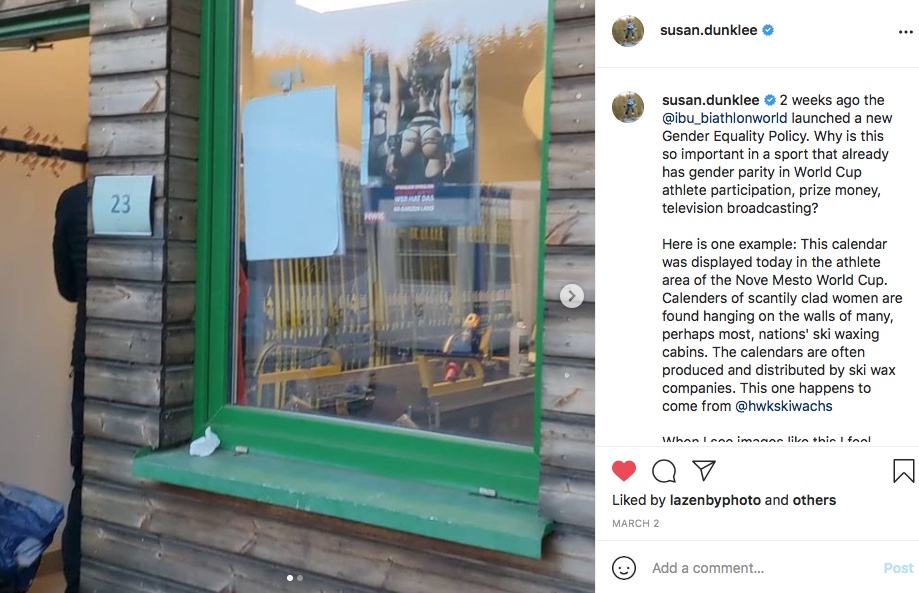
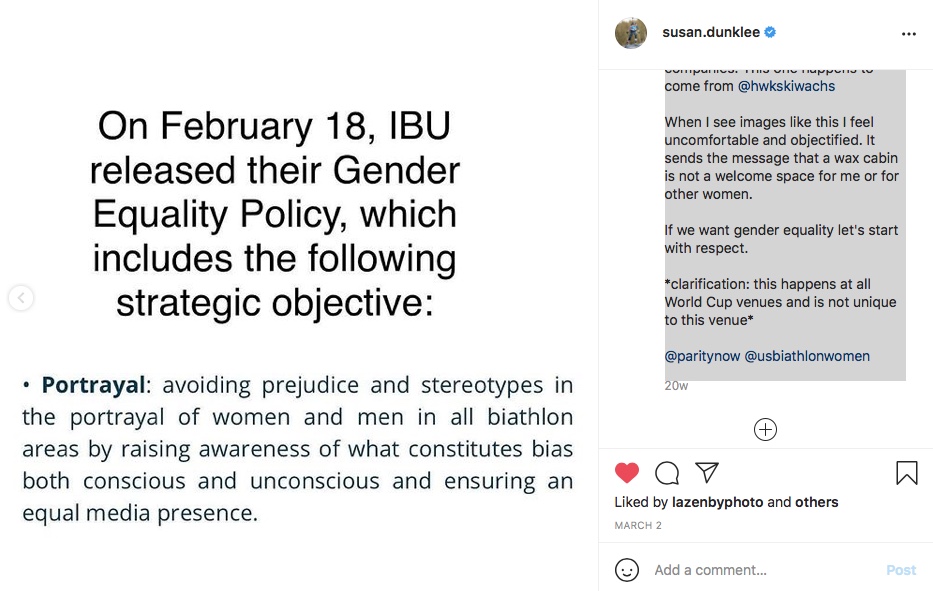
***
FS: Ok, let’s drill down on gender equity in the sport. There have been some inroads in terms of gender equity in male-dominated sports, you know, in some mainstream sports. For example, there’s a female who is an Asian-American General Manager for a Major League baseball team. There’s Becky Hammond who is a longtime assistant coach for the San Antonio Spurs who, you know, living here in Oregon, Hammond was considered for the head coaching job for the Portland Trailblazers – which made some news here, but she did not get the job. There is clearly more work to be done. But those are two examples in very traditional mainstream sports where some headway is being made. But, let’s speak personally about what you see going on in the U.S. in terms of gender equity in biathlon, and then we can jump to the international arena. Specifically, I would like you to discuss what you feel are the issues for gender equity in biathlon?
SD: In the U.S., we have some female coaches, we certainly don’t have as many as we have male coaches. When I’ve looked at the numbers of participants in team trials over the years, we have often had decent size fields on the Junior men’s side and some years we’ve only had three or four women – if that – on the women’s side. For some reason, at the youth level, it seems to be a lot more balanced. I’m not certain why, but we tend to lose a lot of women as they age. And I don’t know why, and I don’t know why that’s not also happening on the men’s side.
I think it can be an intimidating sport to get into. I do know my former teammate, a few years back, Emily Dreissigacker started the Girls with Guns program. This was a workshop for girls to try biathlon. Emily had this experience as a kid where she was deterred from the sport early on because of the weight of the rifle and simply skiing around with a rifle. You know, little things like that are our barriers for people.
Shooting and hunting sports are traditionally more male-dominated spheres. So, the sport can be kind of tricky to get into. It is really nice to know that within our federation we have serious women like Sara Studebaker-Hall, hired to help with our leadership and administration at a really high level. We have Danika Frisbie helping coach and assisting with athlete development. But a few years back, we really didn’t have much of a female presence or leadership either. So we’re getting there, but I would still love to see more girls or programs, specifically for women to develop women coaches and mentor them and give them support.

FS: Off the top of my head, I think Lowell Bailey has been retired for maybe three years now. I’m not sure that is accurate, but he’s retired. Your name and Lowell’s have been associated with the sharp end of the sport now for nearly a decade, you have been the go-tos. And I know Clare has had a really solid run in recent years. But that said, do you feel heard within the U.S. when it comes to your voice for equity?
SD: Oh, yeah, I mean, I would hope I certainly am. I think it can be tougher on the road in the winter because one of the problems with traveling around in a group like ours, is you have a very small group of people that you’re interacting with all the time. And for us, that is the team of athletes, the coaches, our support staff, which includes technicians, physios, sometimes a team doctor. Maybe a press person. And we seldom have any staff on the road that are female. We usually have four female athletes, and then everybody else that we’re traveling around, all winter long, are mostly guys.
I don’t feel like that’s a challenge that is always totally understood or acknowledged within our federation. I don’t know, sometimes they feel like you’re a little bit of a good old boys club socially, and it’s tough, and a lot of our staff represents a wide variety of nationalities. So the norms can be very different.

FS: I think it is well understood that gender inequality has been around for thousands of years. In the recent past, since the #MeToo movement began, it just seemed to be a moment in time, culturally, where people are becoming more aware. But that said, to your liking, and more specifically, has the national federation begun equity training for staff?
SD: I don’t think so. I don’t think that has been a thing, I mean I haven’t been part of any staff training, so I don’t know what they actually have trained in, but I feel like that’s kind of become a hot button issue in the past year or two. And I don’t know. That’s a great question.
FS: And I bring that up because I do feel like, you know, a lot of people know a lot of people maybe roll their eyes and, but the bottom line is that training moves the needle a little bit. It informs people.
You have signed on as an Athlete Ambassador for gender equity at the international federation level. Why did you feel prepared now to take on a leadership role, and then specifically, why gender equity? Although, you have touched upon that already.
SD: I can go into more detail. First of all, I do not feel prepared. And I think I have a long way to go to learn and educate myself about these topics and feel more articulate about them. But I don’t necessarily think that I have to feel 100% prepared to start working on it. The only way I’m going to learn more about this and become more effective at this is by putting my feet in the water.
The incident that really sparked my interest in this occurred this past winter. I don’t know if you follow my Instagram account, but I made a post in March, we were in Nove Mesto towards the end of the season.
And for my entire World Cup career, it has been normal in the wax cabins, of most of the teams I would guess, I don’t know for sure, but I’m assuming, it’s probably most of the teams to have calendars on the walls. Calendars of scantily clad women. And a lot of times these calendars are manufactured and distributed by wax companies. That’s just one of those sorts of things that you just have to accept if you’re going to the World Cup: that this is going to be the culture. You are going to walk into the wax cabin to pick up your race skis or to drop off your skis, and you’re going to see these images all over the wall.
Coming from the US where that sort of thing just seems so outdated to me, it’s like you don’t see images like that in a professional work environment. I think that’s really common still over in Europe and even talking to some of my friends in Germany, they don’t understand why I feel so upset when I see stuff like that. But that’s always bothered me and it’s just kind of been in the background all these years.
My teammates have felt the same way when you walk into a room — you feel objectified when you see shit like that. And we’ve tried some kind of playful and fun ways to bring up the issue. We went to a store and found a male calendar and we put it up on the wax cabin walls.
That’s a tradition that we do once a year or so, and it usually would get ripped down right away by our wax staff. It was very much just kind of a fun way to say, ‘hey this is a thing and we think it’s kind of ridiculous and this is happening and we’re going to try to make it more equal.’
But at the end of the day, I think it’s really better to not have any images at all like that.
So back to my Instagram post – when I was in Nove Mesto at the biathlon venue, I’m walking through the athlete area and I saw on the window, it’s not our team and the team doesn’t really matter, there’s a calendar, one of those calendars, but it’s facing outwards so you can see it from the athlete area.
I thought, ‘Ooh this is a perfect opportunity, I’m just going to take a picture of that.’
I posted the photo on Instagram. And I just talked about it on Instagram, like, ‘Hey this is in the athlete area. And this is kind of a norm, the wax companies actually give out these calendars.’
It created this crazy outrage, I’ve never had an Instagram post go so wild before. The first thing that happened was I had a lot of support and Mona Brorsson and Sebastian Samuelson, some of the Swedes, reposted it too.
The Swedish media picked up on it, absolutely outraged, and I think Sweden is one of the places where gender equality has been thought about for some years now. I think a lot of Swedish media stories actually put some pressure on the wax companies like HWK, which published the particular calendar I had posted a photo of. That response was kind of cool to see.
But, then about 12 hours later the Czech news agencies picked up on the story, and I just got slammed with all sorts of stuff, really negative and poisonous and toxic comments that were hurtful. I was really glad to have my teammates to talk to about that.
But it was like, wow, this is a place where something that I thought was so obvious and that should not be there, there should be no room for this sort of image, and more specifically at the professional sports level like this. The fact that this was so controversial was really enlightening. We have a lot of work to do to create an environment that’s welcoming to everybody.
I think a lot of athletes don’t really feel comfortable speaking up about that stuff and it’s taken me 10 years to speak up about something like the calendar.
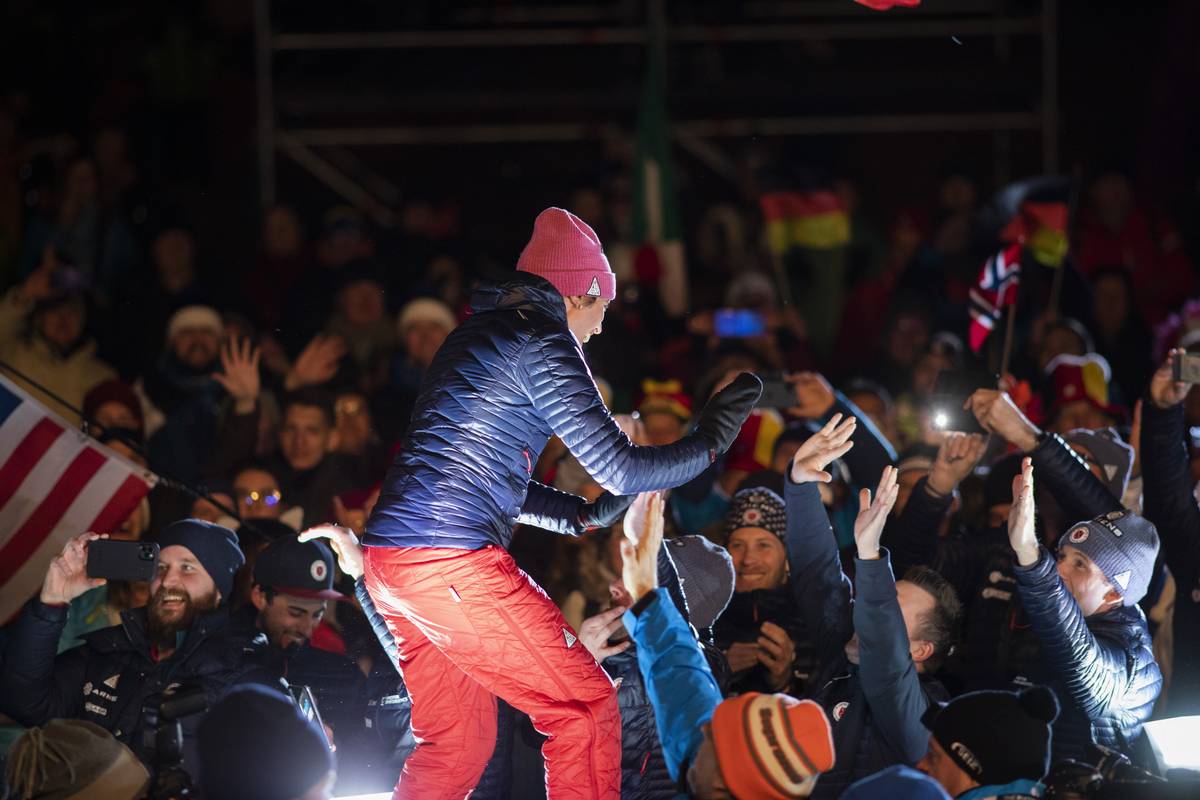
FS: Wow, I’m sorry you were exposed to that type of toxicity. And when you began your story, I defaulted to the trope of automobile or auto-part calendars, not ski wax companies. Some of the biggest role models in skiing across the disciplines are women.
Ok, so you’re talking about the international community with so many different cultural norms. How do you go about it? I’m assuming since you are an IBU Athlete Ambassador, that you have to examine this from an international perspective. If you are thinking of creating solutions, how do you start that discussion or how do you think you should push that discussion to get people in the room who might not necessarily agree with you?
SD: I think from the outside it really looks like a progressive sport in terms of gender equity, sure. It’s one of the few sports out there where women and men have equal prize money, equal participation at the highest level, equal TV coverage for the most part. We even have formats like the single mixed relay and mixed relay where the woman and men race together in the same race, and they’ve even started experimenting with switching the order up so sometimes the guy goes first, sometimes the girl goes first.
And when they do that, it changes the race distance, and in a single mixed relay when the woman goes second she actually skis more kilometers than the man in that race, I think that’s really kind of cool. That’s also controversial and not everybody’s happy with it, including a lot of women, but they’re definitely pushing the envelope on that sort of format.
If you were to look around behind the scenes at a World Cup, you would see one wax technician out of about 100 in total, that is female — her name is Stefani and she’s from Bulgaria. She’s a badass.
You’ll see a couple of coaches perhaps. But, it’s rare to ever see anybody in a technical role, maybe every now and then you might see one woman there, but technical delegates, most international referees, tend to be male.
And I think one of the images that really struck me this spring, I joined an unconscious bias training the IBU was running, and they contracted out with a university in Berlin to run this program. The professor started by showing us a picture of different boards, executive boards from organizations around the world of businesses. Of course, there’s still a lot of businesses that still have a high percentage of older white males on their boards.
Then she showed us a picture of the IBU Executive Board. And even though I know Clare really well and I hear her talk about her work with the IBU on the Executive Board, I had not processed, just how crazy it was that she’s the one woman in that group of 10 people.
Just that visual, to me, was very powerful and as an ambassador, I am trying to identify things that will be powerful for people to see or hear about, and that will help move the needle a little bit.
Yes, it’s interesting to try to think through what are the things people are going to respond to, because, I can see that there’s a problem, but if other people don’t see a problem there’s never going to be change.
FS: What comes to mind is when Laura Ingraham, a conservative commentator, said of LeBron James, “Shut up and dribble,” when the athlete discusses being a Black male in the U.S. I know biathlon is not the NBA, especially in the U.S., but it is a major, if not the major winter sport in much of Europe and Russia. I’m just curious, are you preparing yourself psychologically for some major pushback and people demanding that you stay in your lane?
SD: I did already see a lot on social media. But, I think, going back to where we started in this conversation though, when I view all that corruption in the top leadership, that was really eye-opening to me. And if we didn’t do something as athletes, then nothing was going to change.
I felt like it is and was our responsibility when you see that sort of stuff happening, but you have to speak out about it.
If it’s really important to you, you cannot sit there expecting somebody else to take care of the problem. I think I’ve gone from wanting to focus mostly on my sport and my individual performance, to now where I want to be able to have the time and energy to put energy where it is actually needed.
I think there are times and places where you have to say what matters, what really matters in life, and what type of legacy can I help leave behind.
Yeah, I can leave some good results and that’s something that I can be proud of and the country can be proud of me. But what actually matters in life? I think gender equality is one of these big things that I would love to see a more lasting change.
FS: The Olympic cycle is coming to a close this winter and will start anew. Is this your last year?
SD: It is my last year. I’m done in the spring. This is one of the things, honestly, this kind of work motivated me to go ahead and to see what I can help accomplish on this front, in addition to my racing.
FS: You know this, but every four years, it’s a big cycle for folks, that lead-up into the Olympics and the expectations. Athletes need to compartmentalize. There’s the added attention that you get, and the demands on your energy.
You mentioned this up-front in this conversation, that historically you really just focused on the athlete part, the results-oriented part of the sport. Have you already tried to figure out how you’re going to compartmentalize each of these, the performance side and ambassador side, and make it work?
SD: I think I can do a lot right now over the summer and to start thinking, or at least I’ve been trying to be more strategic in my social media posts, in general, the past year in terms of having to plan for what sort of content I want to put out there. Maybe have a month where I post on one type of type, and I change it up the following month. Then analyzing what picks up steam or people push back against.
I know in Olympic years we can be overwhelmed with media requests. And you can’t say yes to everything and so you have to be strategic about that too. I look forward to relying on teamwork with some of the other ambassadors, being able to chat over stuff with Kelsey Dickinson, who lives here in Craftsbury, and working with the group to coordinate on which things to push for and which things are the most important to tackle and keeping the focus on that.
I think just like having a training plan, having a goal in mind, and a particular roadmap to get to that goal, you have to just not say things willy nilly or, or do things willy nilly, but have a goal that you want to achieve. Right now, I’m in the process of fleshing that out and figuring that out exactly.
Jason Albert
Jason lives in Bend, Ore., and can often be seen chasing his two boys around town. He’s a self-proclaimed audio geek. That all started back in the early 1990s when he convinced a naive public radio editor he should report a story from Alaska’s, Ruth Gorge. Now, Jason’s common companion is his field-recording gear.

